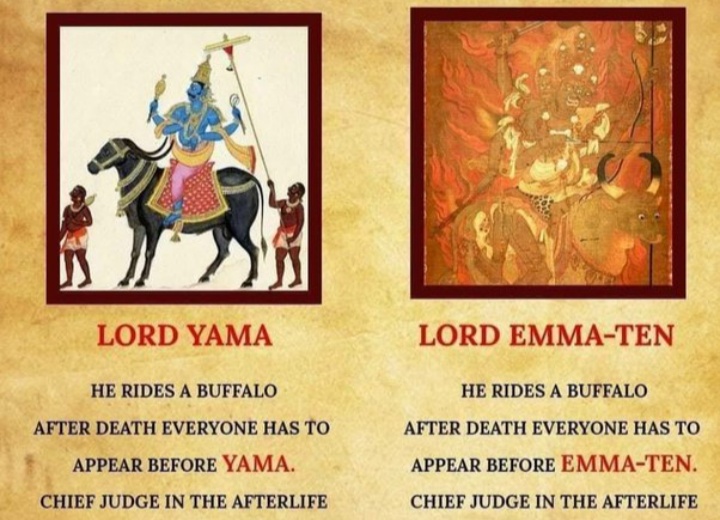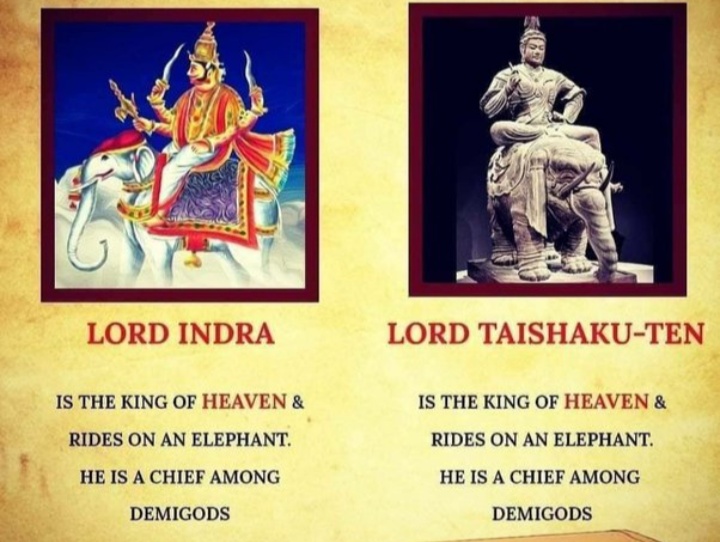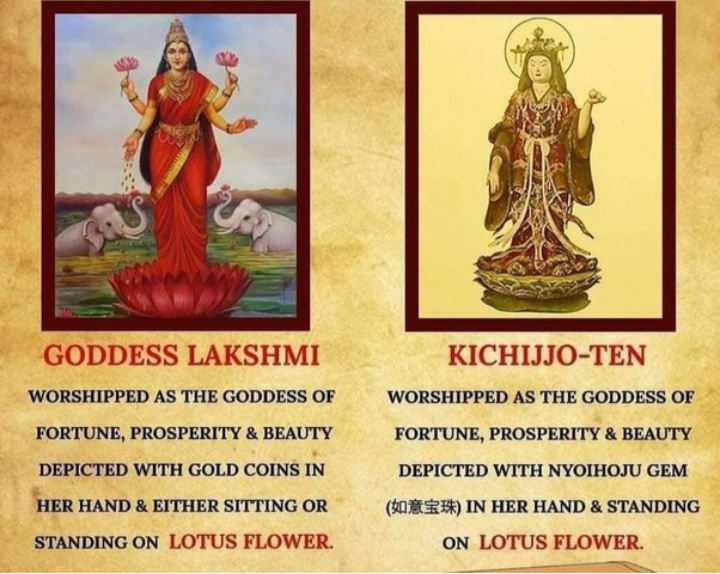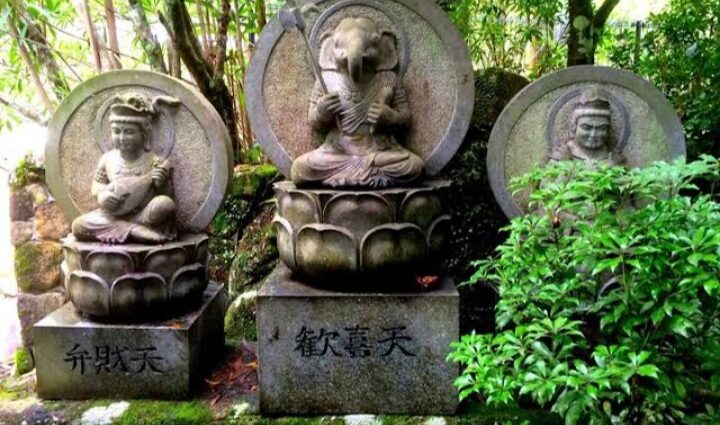The Indic culture of Bharat has always been a torch bearer for various societies around the world seeking the core essence of life. Societies counting from Greeks, Anatolians, Egyptians, Arabs, and Persians to far east lands of Tibet, Indo-China & Mangolia have been the sinks of cultural & spiritual norms cultivated & evolved in Bhārat. When we perceive Bhārat as a civilization and do not restrict her to the concept of a modern nation-state, we unfold various dimensions of her continuity and mutual exchange with other cultural lands. And when we succeed in accomplishing this national devoir, we begin to accept that Sanātan, as a converging matrix or as a larger cultural fold, can be the Matali (charioteer) of the world’s Taladhwaj (chariot), to direct the latter on a victorious path.
Japan was one such land that absorbed the vast & many-hued Indic culture via China & Korean peninsula. Not only Japanese Buddhism but Shintoism also has been considerably influenced by Indian thought. Although syncretism with Buddhism was denounced by the state in the days of the Meiji restoration, we find a strong Indian influence still remaining in present-day Shintoism. Though most of the Shinto- Buddhist followers from Japan are unmindful of this aspect.
Japan has preserved some unique ancient Indic traditions, even when they may have changed here in India. For instance, in Japan, Saraswati is depicted and venerated not only with the Veena but also remembered for her association with water. Therefore, she is also worshiped in pools of water in Japan.
Himalayan Buddhism is a later development and has lost the typical ‘havan’ or ‘homa’. One can trace the continuance of the tradition of ‘homa’ in some of the most important Japanese Buddhist sects, who call it ‘goma’. Sanskrit sutras are also chanted on the occasion and it is much like the ‘havan’.
Hindu influence on Japan also includes the belief of the “six schools” or “six doctrines” as well as the use of Yoga and pagodas.
YASUKUNI ENOKI
Yasukuni Enoki, former Ambassador of Japan in India, once said: “As I come from the Japanese ‘Lakshmi Town’, it is no great surprise to find that Japanese life is full of so many Hindu deities. Since these Hindu deities were introduced into Japan through China, with Chinese names, Japanese people are unaware of their origins.”
INDIC ART HERITAGE DOCUMENTARIES OF BINOY K BEHL
Benoy K Behl is a filmmaker, art historian, and photographer who is known for his tireless and prolific output of work over the past 36 years.
Behl’s films, including 26 documentaries on ‘The Paintings of India’, 26 documentaries on ‘The Sculpture of India’, and 26 documentaries on ‘Spectacular India’ have been nationally telecast on prime time in India. Behl’s film on ‘Indian Roots of Tibetan Buddhism’, with interviews with HH Dalai Lama, won the Best Documentary Producer Award at the Madrid International Film Festival 2015.
THE SIDDHAM SCRIPT
The 6th-century Siddham script is preserved in Japan, though we do not use it in India. ‘Beejaksharas’ of Sanskrit in this script are regarded as holy and are given great importance. Each deity has a ‘Beejakshara’ and these are venerated by the people, even though most of them cannot read it.
Japanese tombs display the Sanskrit alphabet. The Japanese cannot read this alphabet, but it is still used to respect the dead. It is very interesting that the 5th-century Siddham script, which has disappeared in India, is still in use in Japan. At Koyasan, they still have a school where Sanskrit is taught with Siddham.
Sanskrit characters are observed even in Shintoistic rites. Mount Onake is considered a divine being. The Japanese have a tradition of climbing Mount Onake as a religious observance wearing traditional white robes. Sometimes Sanskrit characters (siddham), much older than Devanagari characters, are written on these robes. They sometimes wear white Japanese scarves (tenugui) on which the Sanskrit character ‘Om’, the sacred syllable of the Hindus, is written, although the climbers themselves cannot read it.
BODHISENA
In the eighth century, the Indian priest Bodhisena was invited by the Japanese Emperor to Japan. He conducted the eye-opening ceremony of the Great Buddha of the Todaiji temple in 752. Bodhisena is believed to have been from South India. His statue is situated at Ryosenji Nara.
BUDDHISM
Buddhism came to Japan through Korea in the latter half of the 6th century. In 552, through the agency of the King of Pekche (Kudara), in southern Korea, the royal gifts of a statue of Buddha, the Sutras (Scriptures) and banners were presented to the Japanese Emperor, with a message to the effect that the Buddhist Dharma (doctrine), the most excellent of all doctrines which would bring immeasurable benefits to its believers in Japan, had been accepted in all countries lying between India and Korea.
NIPPONIZED INDIAN GODS & DEMONS
Many of the Indic scriptural figures can be identified from their Nipponized version. A brief introduction is here :
SHO-DEN
Ganesha, the Indian god of wisdom, is worshipped under the name of Sho-den, in many Buddhist temples, as one who confers happiness upon his votaries, especially in love affairs. In Japan we very often find figures of two Ganeshas, male and female, embracing each other (Mithuna).

BISHAMON
Bishamon is a Japanese equivalent of the Indian Vaishravana (Kubera), the god of fortune. Bishamon was worshipped by warriors in the feudal times for victory.

SUITEN
Suiten (water god) is a Shintoist name. But the god, widely worshipped by people in downtown Tokyo, was originally Varuna and was introduced into the Buddhist pantheon by esoteric Buddhism, and then adopted by Shintoists.

KOMIPORA
Kompira, a god of sailors, is worshiped at Kotohira shrine, in Kagawa prefecture, on the island of Shikoku. Kompira is a corrupt form of Kumbhira, a Sanskrit word for a mythological crocodile in the Ganges.

BENZAITEN
Benzaiten is the Chinese and Japanese equivalent of Sarasvati. Benzaiten arrived in Japan during the 6th through 8th centuries, mainly via the Chinese translations of the Sutra of Golden Light, which has a section devoted to her. She is also mentioned in the Lotus Sutra. In Japan, the lokapālas take the Buddhist form of the Four Heavenly Kings. The Sutra of Golden Light became one of the most important sutras in Japan because of its fundamental message, which teaches that the Four Heavenly Kings protect the ruler who governs his country in the proper manner. Along the sea coast and around ponds and lakes, one often finds shrines of Benzaiten where her image is installed. Some of these images look very erotic and coquettish.

DAIKOKU
Daikoku, a god of fortune (literally, god of great darkness or blackness) is a favorite god with the common people. The name is the Chinese and Japanese equivalent of Mahakala, another name for Shiva, the mightiest god in the Hindu pantheon. Though Daikoku is clad in Japanese robes and has a benign and smiling countenance.
VISHVAKARMA
Visvakarman, maker of the world in the Rg-veda, was also esteemed as the god of carpenters in the royal court in ancient times under the name of Bishukatsuma as is mentioned in the historical work ‘Eiga monogatari’.
NAGA & HARITI-DAKINI
A sea serpent, worshiped by sailors, is called Ryujin, a Chinese equivalent of the Indian naga. Hariti and Dakini, Indian female demons, are also worshipped; the former under the name Kishimojin, and the latter retaining its original name.
INDIC INFLUENCE ON –
PAINTINGS
A unique example of the Indian Gupta style of painting will be seen in the fresco painting of the Golden Hall of the Horyuji temple. This can evidently be traced to the same original source as the wall paintings of the cave temples of Ajanta in India. The most primitive paintings in Japan are found on the walls of chambers of burial molds built in Kyushu in the prehistoric period. They consist mainly of totemic symbols and geometric patterns in red, green, white and yellow.
In the 9th century, a new style of painting was brought in with the introduction of Chinese esoteric Buddhism. In the later Heian period (794-1192) the pictures representing Amida (amitabha) and his attendant Bodhisattvas, all descending from the heavenly pure land, were most popular. The Buddha altar of a Buddhist temple is called Shumidan (viz. Sumeru throne). The name has been derived from the highest mountain in Indian mythology.
MUSIC & DANCE
The court dance and music (called Bugaku or Gagaku) introduced into Japan 1,200 years ago from India, directly by Bodhisena, the Indian monk and Fu Ch’e, a Vietnamese, are preserved in their original form to this very day. The original form is not preserved in present-day India, nor in other Asiatic countries. It is a unique cultural asset found only in Japan. The Japanese are justly proud of this art that they have preserved through the centuries. From the time it was first introduced into this country, the court dance and music were given careful attention and protection by the Imperial Household. The formal stage for this art is found in the Imperial Palace.
The names of some pieces of the music can be traced to Indian originals, e.g.: bosatsu, is the Japanese corruption of bodhisattva; Bairo of Bhairava, karyobin of Kalavinka – a sonorous, sweet-voiced bird. The dancers all wear red masks and peculiar costumes. Biwa, a Japanese musical instrument, is the corrupt form of the Sanskrit word vina. Originally this musical instrument came to China from India, but by the time of the T’ang dynasty it seems to have assumed the air of being a Chinese instrument. It was used already in the Nara period.
RITUALS
The custom of cremation was also introduced to this country from India. The rituals of our ancestor worship have been tremendously influenced by Indian customs, some of which can be traced back even to those practiced by the Dravidians, Mundas, etc. They offered water, flowers, rice cakes and incense to their ancestors. Historical records show that an Indian drifted to the shore of Aichi prefecture in AD 799 and taught the people how to cultivate cotton. An ethnology scholar has pointed out that there is evidence that an Indian community existed in the Shima district in Mie prefecture.
ENTERTAINMENT
The sugoroku (backgammon) game was played in the Imperial court in the Nara period. While playing, players shook two dice from the box onto the board, to move their pieces in the game. This game is very popular among common people even now, especially on the days of the New Year festival. According to Wei-shu, sugoroku was a Hu game imported into China quite long ago. Hu at that time meant a country somewhere near India. It perhaps entered China in the late Wei period (presumably in the 5th century). The dice used in sugoroku is a six faced cube numbered 1 to 6. It is extremely interesting to note that the dice is marked similarly throughout the world from ancient times. Among the findings of the ancient Indus civilization, one will find dice of exactly the same form as are used nowadays in Japan.
Today Hinduism is practiced mainly by Indian and Nepali migrants in Japan. Hindu gods are still revered by many Japanese, particularly in Shingon Buddhism. The few Hindu temples in Japan are as follows:
•Shiva Shakti Temple and Ashram, Tokyo
•ISKCON New Gaya
•Benzaitensama Shrine (Saraswati Shrine)
•Ganesha Temple, Asakusa
SOURCES
1. Mayo Japan Youtube
2. www.Inditales.com
3.Chaudhuri, Saroj Kumar. Hindu Gods and Goddesses in Japan
4. Our civilizational imprints from Bharat to Japan. Pragyata
- BHĀRAT: EVOLUTION OF A DYNAMIC & DIVINE RĀSHTRA - September 12, 2023
- ECHOES OF INDIC FACETS EMBEDDED IN JAPANESE CULTURE - July 7, 2023
- YOGINIS: SACRED FEMININE DIVINITY & ENLIGHTENMENT - May 25, 2023

